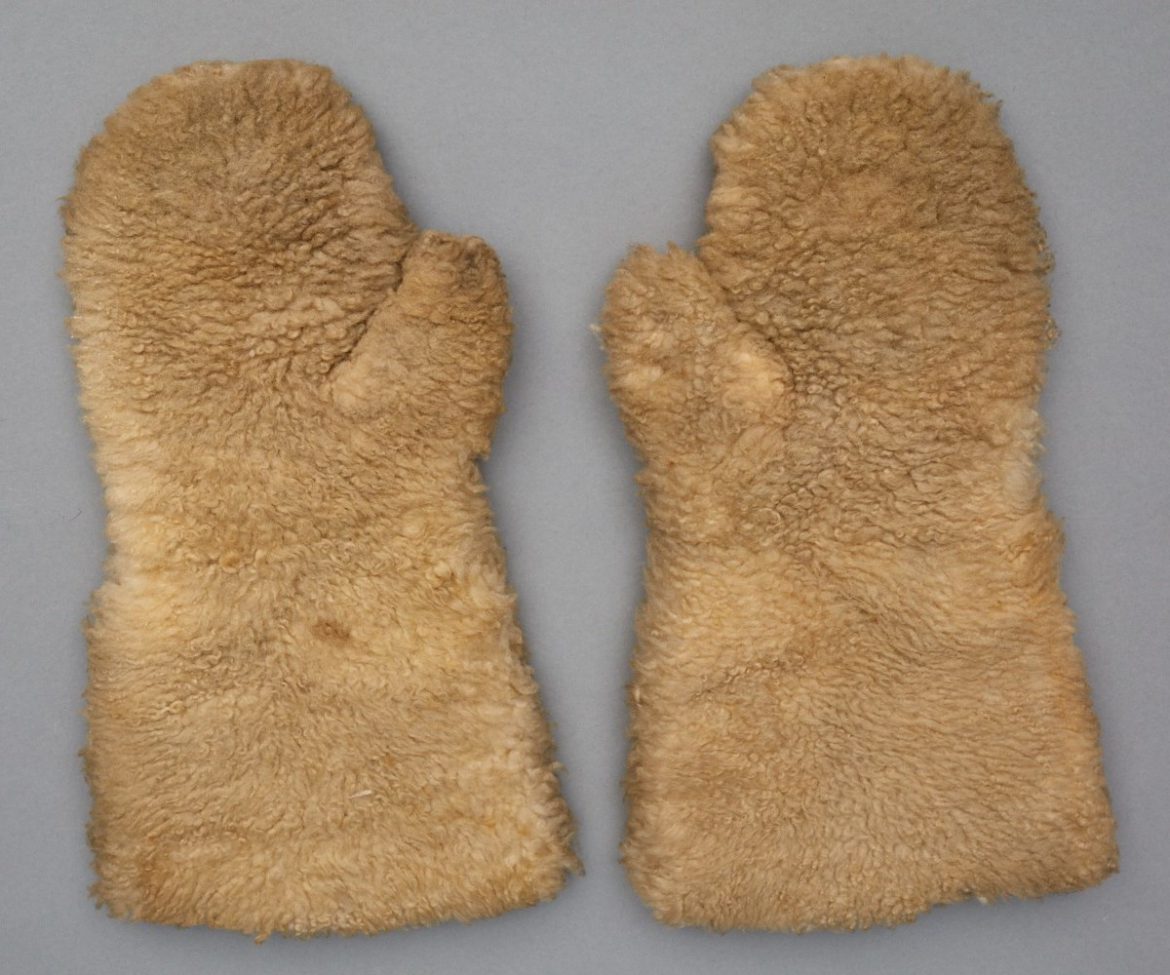
Sheep Skin Mittens, Church Family, Mount Lebanon, NY, ca. 1880, Shaker Museum | Mount Lebanon: 1956.8175.1a,b. John Mulligan, photographer.
“Thumb in the thumb place, fingers all together. This is the song we sing in mitten weather.” When March came in like a lion this year and the snow on Lebanon Mountain reached nearly two feet, our thoughts turned to the challenges the Shakers faced during the cold time of year. It was not unusual for a company of […]
“Thumb in the thumb place, fingers all together.
This is the song we sing in mitten weather.”
When March came in like a lion this year and the snow on Lebanon Mountain reached nearly two feet, our thoughts turned to the challenges the Shakers faced during the cold time of year. It was not unusual for a company of brethren to take to the mountain road with snow shovels where, for example, in March of 1852 they were “compelled to break roads thro the snow banks.” Even with clear roads, winter travel by wagon or sleigh was cold. Special clothing for winter travel was necessary to travel at all. The Museum has several pairs of what are presumed to be mittens for teamsters. The mittens, made from sheep skin with the wool left on the outside of the mittens, were not particularly flexible and useful for handwork, but were certainly suitable to hold tight to a pair of reins and keep the driver’s fingers from freezing.

Sheep Skin Mittens, Church Family, Mount Lebanon, NY, ca. 1880, Shaker Museum | Mount Lebanon: 1956.8175.1a,b. John Mulligan, photographer.
These teamster’s mittens were a gift from Peter Joray of Chatham Center, New York. Joray was the author of several articles in the 1960s about the Shakers at Mount Lebanon and had been a frequent visitor to the Shakers when they still lived there. When received by the Museum the name Henry Clough was found written on the edge of the inside of the cuff of both mittens, along with what might have possibly once read, “Mount Lebanon, N. Y. Shakers.” Brother Henry Terry Clough was born in September 1862 in Plymouth Hollow, Connecticut. He was admitted to the Church Family in 1873 where he attended school until he was fifteen years old. At age 18 the 1880 U. S. Federal Census identified him as a teamster. It would make sense for the mittens to have dated from this time. Brother Henry eventually worked at the Second Order of the Church Family (later called the Center Family) in the herb business. At the end of April 1890 Brother Henry determined to sever his relationship with the Shakers and left for New York City. His plan upon leaving the Shakers involved rendezvousing with Sister Julia Matilda (Minta or Mintie) Dalton, who had taken leave of the Church Family ostensibly for an extended visit with relatives three months earlier. They married, had five children, and lived in New York City where Henry had a successful career with a jewelry company. In February 1909, seemingly nostalgic for the simplicity of community life, they both returned to the Shakers with their children. Henry, with his previous experience in the herb business, was re-employed there. In September 1921, the Cloughs again decided to leave their Shaker home and moved their household furniture to a home they owned in Lebanon Center.

Paper Pattern, Glove, Church Family, Mount Lebanon, NY, 1867, Shaker Museum | Mount Lebanon: 1956.8503.42a,b. Staff photograph.

Paper Pattern, Mitten, Church Family, Mount Lebanon, NY, 1867, Shaker Museum | Mount Lebanon: 1956.8503.12a,b (mitt); 1956.8053.5b (thumb). Staff photograph.
These mittens were most likely made by the Shakers. The Museum holds a number of patterns from the Mount Lebanon Shakers for making both mittens and gloves. They were made for multiple purposes and from a variety of materials – cloth as well as various leathers. While the Museum does not have the pattern for Brother Henry’s teamster mittens, it does have in its collection a pattern for “Large Size” gloves dated 1867 “For Sheep skin gloves – wool on” that show the Shakers were making hand coverings that were intended for work in the cold. A typical mitten pattern had two pieces – one pattern for cutting the mitt and the other for the thumb. An example made in December 1842 “For handing Mittens – Right Size for Dwight H[inkley], &c.” is identified as “Latest and best fashion ever introduced.” While the thumb pattern is missing, the pattern is also identified as “No 4 – Thumb and hand.” Borrowing a thumb pattern from an 1847 “Pattern for Glove handing No 4 thumb & hand,” made for “H. D. W. [i.e., Brother Henry De Witt] allows a vision of how the mitt and thumb patterns worked together to make a full mitten. Rights and lefts were determined by merely flipping the pattern over when it was being traced onto the cloth or leather. These patterns rarely include a cuff – an attached extension that continued the glove or mitten up the arm – but most would have certainly had them. One pattern merely states that the cuff should be cut three by nine inches and attached.
The Shakers’ making of gloves and mittens is an area that has not been very well explored. While knit, felt, and cloth hand-wear falls neatly into the subject of Shaker textile arts, gloves and mittens made of various leathers appear, like shoe and hat making, to fall under the broader subject of Shaker costume – one that could use considerably more scholarship.